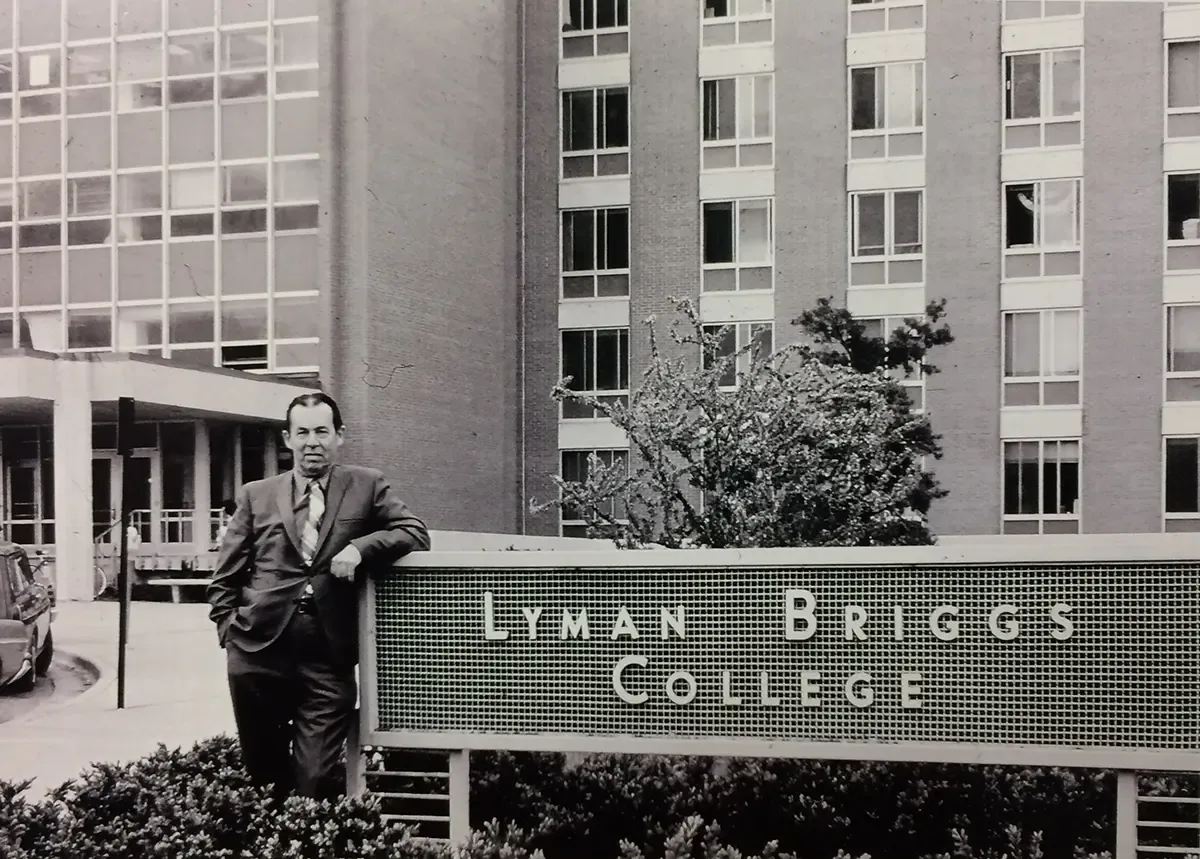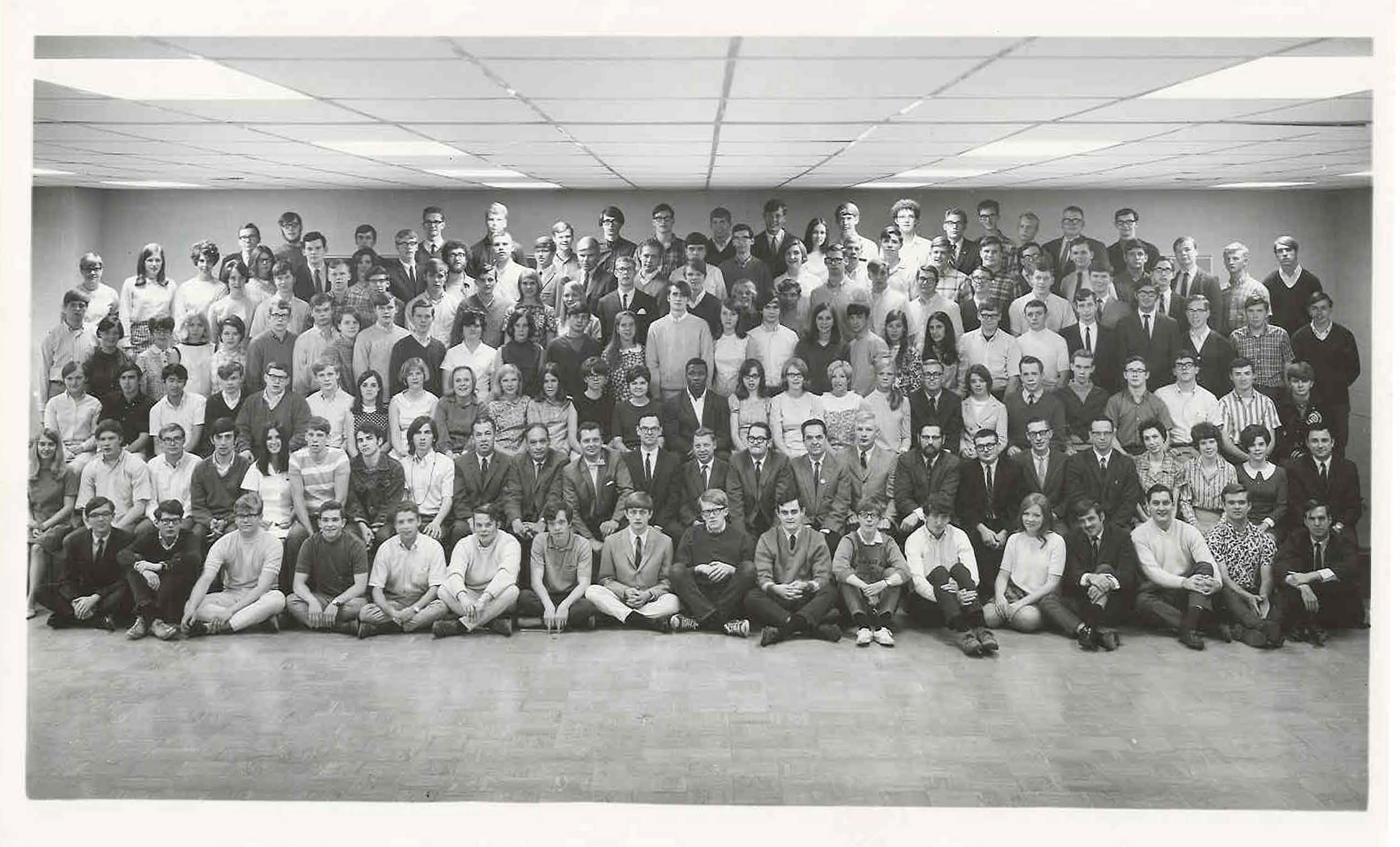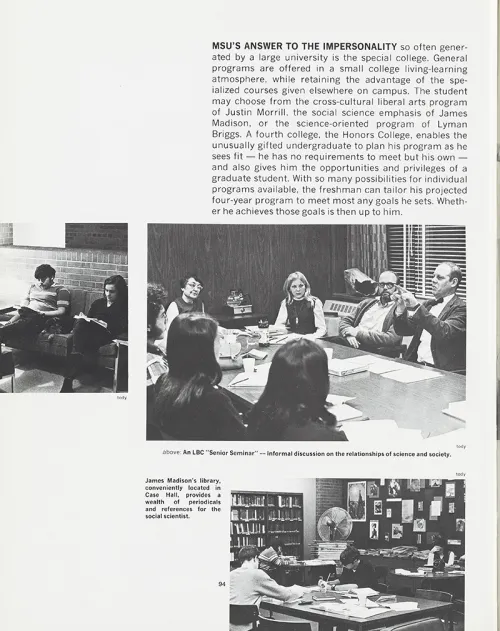Since 1967, Lyman Briggs College has been innovative and responsive, and has fostered a community of students, faculty and staff who are passionate about science and its place in society.

The following is the first chapter of LBC's history.
One of MSU's Big Ideas
It was the mid 1960's and Michigan State University had welcomed an influx of students in the years after World War II. Thanks to MSU President John Hannah's foresight, over a dozen dormitories had been built around the edges of campus to accommodate expanded enrollment.
Across colleges and universities in North America, a new concept was being put forth, based on the "Living-Learning" model: the residential college, which was said to provide the best environment for undergraduate students. In this model, the students would have access to academic classrooms and labs, along with staff and faculty offices within the same buildings in which they lived.
In 1965, under the academic leadership of Provost Neville, MSU established its first residential college, Justin Morrill College, focused on the arts and humanities.
Shortly thereafter, two consecutive committees of faculty from across the university* were called together to plan "College II," which would be a residential college in the sciences with a focus on the role of science in society. The MSU Board of Trustees approved initial plans and called another planning committee under the leadership of Dr. Frederic B. Dutton. He had been the director of the MSU Science and Mathematics Teaching Center. The same year, James Madison College, the third residential college with a focus on social policy, was established.
In February 1967, the MSU Board of Trustees approved the second planning committee's reports as well as the name of Lyman Briggs College. Lyman J. Briggs had been a distinguished alumnus of Michigan State University, an accomplished engineer and physicist who later worked in the federal government. F.B. Dutton was named the college's inaugural dean, and staff and faculty were hired.
McDonel Hall and Holmes Hall had been constructed in 1965, with the first physical and biochemical labs (with fume hoods) ever included in residence halls. Holmes included six classrooms in the upper C-wing, and three labs in the lower. Science was, in a way, built into the foundations of Holmes Hall.
In 1967, Lyman Briggs College opened for the first time and welcomed 224 students: 166 men were housed on the fifth and sixth floors of East and 58 women were housed on the sixth floor of West.
In 1970, Mary Ruwart was the first graduate of Lyman Briggs College, having completed her coursework in only three years.
In 1971, the first graduating class included 76 individuals.

Early Innovations

LBC as a residential science college presented many advantages: Smaller numbers of students in classes, a close-knit community, and the opportunity for faculty to use innovative methods and ways of teaching. Even the structure of having faculty members jointly appointed in Lyman Briggs and other university departments was experimental.
Other innovations:
- Computer programming courses were offered and computers integrated into math courses in the 1960's
- Introductory biology courses were developed which did not require a student to know the principles of organic chemistry
- Initial biology lectures were recorded and shared in lecture, with recitation and laboratory facilitated by graduate teaching assistants
- Chemistry and physics were taught sequentially, to avoid topical repetition
- Majors were eventually coordinated across the university to allow students to have foundational science courses in Lyman Briggs before focusing on "fields of concentration"
- Written and spoken communications were emphasized in all courses
- An introductory writing course was crafted by a professor in the Department of American Thought and Culture, called Third Culture Rhetoric. The course was a response to the theories of British physical chemist and novelist C. P. Snow, "The Two Cultures and The Scientific Revolution" which proposed a third culture to bridge the cultural divide between the sciences and the humanities
- Additional courses in the "Third Culture" vein would include Logic, the History of Science, and the Philosophy of Science
- Two years after the college was founded, Undergraduate Learning Assistants were employed in courses for the first time, providing knowledgeable and enthusiastic support for their peers in LB classes
Student Involvement
The student voice has always been important at Lyman Briggs.
Early in LBC's first year, a Student Advisory Committee was formed. It was responsible for the "co-curricular" nature of college life for Briggsies. In addition, these students would come to have open meetings and would represent student concerns to faculty and administration.
In 1970, three LBC students presented "An Undergraduate View of Science Education" at the December meeting of the American Association for the Advancement of Science. Students were invested and involved in the ongoing development of Lyman Briggs College and its innovation.
Responding to World Events
The late 1960's was a tumultuous period of world history. Between the divisive Vietnam War, the growing feminist and Civil Rights movements, and events like the Kent State Massacre, students craved more discussion of world events in classes and beyond. In response to Kent State, some LBC faculty members held classes in their homes. The college observed Moratorium Day as well.
The "Third Culture" curriculum evolved from a fairly narrow set of course offerings to courses that explored society and the cultural impacts of science. That area of study in Lyman Briggs changed its name to "Science Studies." This curricular expansion has only gotten broader over time, and has become a component of the Lyman Briggs curriculum.
*Representatives from the College of Natural Science, the Departments of Chemistry, Entomology, Philosophy, Psychology, Mathematics, and Physics initially laid out plans and considerations for how the college could work. The second planning committee included representatives from the Departments of Botany, Plant Biology and Biochemistry, and the College of Natural Science.